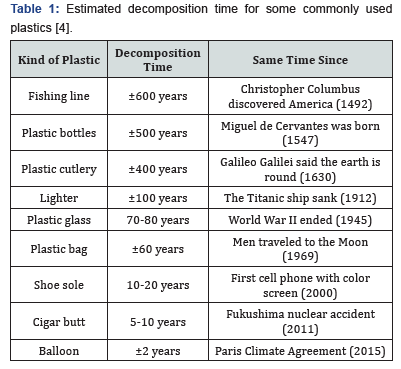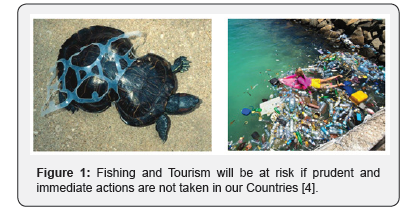Organic & Medicinal Chemistry - Juniper Publishers
Abstract
This year the campaign to stop plastics pollution has
increase. On Social Media it is used the theme: #Beat Plastic
Pollution. Such actions are crucial in the implementation of the 2030
Agenda for Sustainable Development and its SDGs, and the Paris Agreement
on Climate Change, including through engaging in political advocacy,
providing expertise and insights on potential policy choices, as well as
being directly responsible for the implementation of many of these
decisions [1]. At the moment, humanity makes about 300 million tons
of plastic every year. And half of it is used only once (like bags and
wrapping). Approximately 10% of it is recycled and the rest goes to
garbage dumps/landfills and rivers. According to a recent study, 10
rivers (2 in Africa and 8 in Asia) transport 90% of all the plastic that
ends up in oceans. The scale of pollution is awful and many of us don’t
even realize how bad this situation is [2]. Countries in the world are
mobilizing to ensure they become nations free of plastic bags and straws
and polystyrenes takeaway boxes, among other undesirable plastics by
the end of present year 2018. The ban on these plastics is an
opportunity for us to help protect our planet and to strengthen our
sustainable cultural practices [3].
Keywords: Plastics Pollution; Water Pollution; Land Pollution; Air Pollution; Sustainable Development; Climate Change
Discussion
Discussion
Over the time, our oceans have increasingly become
dumping grounds for different types of waste, including sewage,
industrial waste, chemicals, plastics and litter. An estimated 80% of
marine pollution originates from land-based sources including wastewater
and nutrients loadings. Worldwide, pollution in coastal waters has
increased exponentially during the last decades due to population growth
and the increasing number of anthropogenic activities. Coral reefs are
particularly vulnerable to wastewater and nutrient pollution, which
consequently threatens the health and well‐being of hundreds of millions
of people who depend on coral reef ecosystem services for nutrition,
livelihoods and a safe living environment. With the influences of ocean
warming and coral bleaching impacts, land-based pollution constitutes a
significant additional threat that must be addressed with urgency.
you choose. There is the hawksbill turtle struggling
to free itself from a plastic bag. The sea of polystyrene trash floating
over a Caribbean nature reserve. Or the sperm whale washed ashore, its
stomach filled with plastic waste. Pieces of plastic are sharp, brittle,
toxic, and routinely found in the stomachs of dead fish, turtles, and
marine mammals. Plastics can come with a range of hazardous additives
and can act as a chemical sponge, soaking up and concentrating other
pollutants. Marine species, including
fish, seabirds and even marine mammals, can end up eating pieces of
plastic, and at the same time get an additional dose of toxic chemicals.
Since the introduction of mass-produced plastics in
the early 20th century, humanity has produced an estimated 8,300 million
tons of the stuff. Around three-quarters has been thrown away, and 80%
of that has drifted into the environment or gone into a landfill.
Approximately, eight million tons a year end up in the ocean, it makes
more than 5 trillion pieces and counting. It is an environmental catastrophe and a human one,
too, as some people in parts of the developing world live ankle-deep in
filthy, non-biodegrading plastic trash (Table 1). The long-term health
implications for all of us remain uncertain, as ingested plastic works
its way up to the food chain. Everyone agrees something must be done.
From banning plastic straws to rebooting recycling systems to harnessing
plastic-munching bacteria, there is no shortage of touted solutions. It
is less clear what would work best. But fixing the plastic waste crisis
is going to take some seriously joined-up thinking. If we make the
wrong decisions now, we risk making the problem worse. If plastics
didn’t exist, we would have to invent them. Generally made of
oil-derived polymers, they can be hung with different chemical groups
and spiced up with additives to give them wildly differing properties
such as hardness, strength, density and heat-resistance. This makes them
just the thing for everything from
colorful, durable kids’ toys Figure 1.


We need to tackle the problem of marine debris head on. It’s
not just an issue for environmentally conscious, it is an issue that
ultimately affects human health. Man is a top predator that feeds
on a variety of ocean fish, shellfish and other marine species. We
face the same risks as the killer whale and polar bear. While any
plastic or polystyrene pellets that may have been clogging the
gut of the fish that is nicely presented on our dinner plate have
been long removed, the toxic contaminants originating from that
debris remain stored in the flesh we are about to eat. Food for
thought indeed. Some scientists are suggesting that burning plastic could
be the most environmentally-friendly way to get rid of it. They
base it on the fact that plastics are composed of a mixture of
hydrocarbons with varying chain length, mainly long chain
hydrocarbons. They support the theory that there is not big
difference with other fuels apart from some halogens and Sulphur
that can be removed from any emissions using appropriate filters
and sequesters [1-4].
Conclusion
When we deal with plastics pollution, we should be sober in
adopting solutions. Climate Change and the Loss of Biodiversity
remain our top environmental concerns, and we cannot afford
to adopt plastic alternatives that increase, not decrease, our
impact on the planet. A cotton tote bag or steel water bottle may
generate higher carbon emissions over its lifetime. A rush to bioderived
plastics may, as with bio-fuels, increase land cleared for
crops. Plastics that degrade faster risk increasing the scourge
of microplastic in the environment if not partnered with better
waste management.
Some solutions to reduce plastic pollution are specific
actions policy makers can take to improve waste management,
promote eco-friendly alternatives, educate consumers, enable
voluntary reduction strategies and successfully implement bans
or levies on the use and sale of single-use plastics, etc. World
Environment Day 2018 issued a call to action to individuals,
governments, the public and the private sector to examine joint
solutions to reduce the heavy burden of plastic pollution on our
natural places, our wildlife and our own health. Now more than
ever Zac Goldsmith quote is a proven statement: “Of all the waste
we generate, plastics are perhaps the greatest symbol of our
throwaway society. They are used, then forgotten, and they leave
a terrible legacy”.
To Know more about Organic & Medicinal Chemistry
Click here: https://juniperpublishers.com/omcij/index.php
To Know more about our Juniper Publishers
Click here: https://juniperpublishers.com/index.php





No comments:
Post a Comment